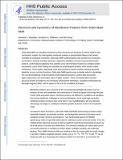Structure and dynamics of membrane proteins from solid-state NMR
Author(s)
Mandala, Venkata Shiva; Williams, Jonathan Kyle; Hong, Mei
DownloadAccepted version (1.549Mb)
Terms of use
Metadata
Show full item recordAbstract
Solid-state nuclear magnetic resonance (SSNMR) spectroscopy elucidates membrane protein structures and dynamics in atomic detail to yield mechanistic insights. By interrogating membrane proteins in phospholipid bilayers that closely resemble biological membranes, SSNMR spectroscopists have revealed ion conduction mechanisms, substrate transport dynamics, and oligomeric interfaces of seven-transmembrane helix proteins. Research has also identified conformational plasticity underlying virus-cell membrane fusions by complex protein machineries, and β-sheet folding and assembly by amyloidogenic proteins bound to lipid membranes. These studies collectively show that membrane proteins exhibit extensive structural plasticity to carry out their functions. Because of the inherent dependence of NMR frequencies on molecular orientations and the sensitivity of NMR frequencies to dynamical processes on timescales from nanoseconds to seconds, SSNMR spectroscopy is ideally suited to elucidate such structural plasticity, local and global conformational dynamics, protein-lipid and protein-ligand interactions, and protonation states of polar residues. New sensitivity-enhancement techniques, resolution enhancement by ultrahigh magnetic fields, and the advent of 3D and 4D correlation NMR techniques are increasingly aiding these mechanistically important structural studies.
Date issued
2018Department
Massachusetts Institute of Technology. Department of ChemistryJournal
Annual Review of Biophysics
Publisher
Annual Reviews
Citation
Mandala, Venkata S., Jonathan K. Williams, and Mei Hong, "Structure and dynamics of membrane proteins from solid-state NMR." Annual Review of Biophysics 47, 47 (2018): p. 201-22 doi 10.1146/ANNUREV-BIOPHYS-070816-033712 ©2018 Author(s)
Version: Author's final manuscript
ISSN
1936-1238